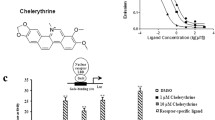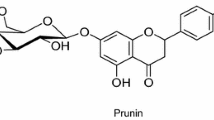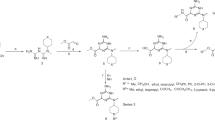Abstract
Diabetes mellitus is one of the greatest global health issues and much research effort continues to be directed toward identifying novel therapeutic agents. Insulin resistance is a challenging integrally related topic and molecules capable of overcoming it are of considerable therapeutic interest in the context of type 2 diabetes mellitus (T2DM). Protein tyrosine phosphatase 1B (PTP1B) negatively regulates insulin signaling transduction and is regarded a novel therapeutic target in T2DM. Here, we investigated the inhibitory effect of α-methyl artoflavanocoumarin (MAFC), a natural flavanocoumarin isolated from Juniperus chinensis, on PTP1B in insulin-resistant HepG2 cells. MAFC was found to potently inhibit PTP1B with an IC50 of 25.27 ± 0.14 µM, and a kinetics study revealed MAFC is a mixed type PTP1B inhibitor with a K i value of 13.84 µM. Molecular docking simulations demonstrated MAFC can bind to catalytic and allosteric sites of PTP1B. Furthermore, MAFC significantly increased glucose uptake and decreased the expression of PTP1B in insulin-resistant HepG2 cells, down-regulated the phosphorylation of insulin receptor substrate (IRS)-1 (Ser307), and dose-dependently enhanced the protein levels of IRS-1, phosphorylated phosphoinositide 3-kinase (PI3K), Akt, and ERK1. These results suggest that MAFC from J. chinensis has therapeutic potential in T2DM by inhibiting PTP1B and activating insulin signaling pathways.






Similar content being viewed by others
References
Ala PJ, Gonneville L, Hillman M, Becker-Pasha M, Yue EW, Douty B, Wayl B, Polam P, Crawley ML, McLaughlin E, Sparks RB, Glass B, Takvorian A, Combs AP, Burn TC, Hollis GF, Wynn R (2006) Structural insights into the design of nonpeptidic isothiazolidinone-containing inhibitors of protein-tyrosine phosphatase 1B. J Biol Chem 281:38013–38021
Badr JM, Shaala LA, Youssef DTA (2013) Loranthin: A new polyhydroxylated flavanocoumarin from Plicosepalus acacia with significant free radical scavenging and antimicrobial activity. Phytochem Lett 6:113–117
Baskaran SK, Goswami N, Selvaraj S, Muthusamy VS (2012) Molecular dynamics approach to probe the allosteric inhibition of PTP1B by chlorogenic acid and cichoric acid. J Chem Inf Model 52:2004–2012
Bharatham K, Bharatham N, Kwon YJ, Lee KW (2008) Molecular dynamics simulation study of PTP1B with allosteric inhibitor and its application in receptor based pharmacophore modeling. J Comput Aided Mol Des 22:925–933
Cerón-Romero L, Paoli P, Camici G, Flores-Morales V, Rios MY, Ramírez-Espinosa JJ, Hidalgo-Figueroa S, Navarrete-Vázquez G, Estrada-Soto S (2016) In vitro and in silico PTP-1B inhibition and in vivo antidiabetic activity of semisynthetic moronic acid derivatives. Bioorg Med Chem Lett 26:2018–2022
Cornish-Bowden A (1974) A simple graphical method for determining the inhibition constants of mixed, uncompetitive and non-competitive inhibitors. Biochem J 137:143–144
Cui L, Na M, Oh H, Bae EY, Jeong DG, Ryu SE, Kim S, Kim BY, Oh WK, Ahn JS (2006) Protein tyrosine phosphatase 1B inhibitors from Morus root bark. Bioorg Med Chem Lett 16:1426–1429
de Koning EJ, Bonner-Weir S, Rabelink TJ (2008) Preservation of beta-cell function by targeting beta-cell mass. Trends Pharmacol Sci 29:218–227
Dixon M (1953) The determination of enzyme inhibitor constants. Biochem J 55:170–171
Elchebly M, Payette P, Michaliszyn E, Cremlish W, Collins S, Loy AL, Normandin D, Cheng A, Himms-Hagen J (1999) Increased insulin sensitivity and obesity resistance in mice lacking the protein tyrosine phosphatase-1B gene. Science 283:1544–1548
He RJ, Yu ZH, Zhang RY, Zhang ZY (2014) Protein tyrosine phosphatases as potential therapeutic targets. Acta Pharm Sin 35:1227–1246
Jeong SY, Nguyen PH, Zhao BT, Ali MY, Choi JS, Min BS, Woo MH (2015) Chemical constituents of Euonymus alatus (Thunb.) Sieb. and their PTP1B and α-glucosidase inhibitory activities. Phytother Res 29:1540–1548
Jiang CS, Liang LF, Guo YW (2012) Natural products possessing protein tyrosine phosphatase 1B (PTP1B) inhibitory activity found in the last decades. Acta Pharmacol Sin 33:1217–1245
Johnson TO, Ermolieff J, Jirousek MR (2002) Protein tyrosine phosphatase 1B inhibitors for diabetes. Nat Rev Drug Discov 1:696–709
Jung HJ, Jung HA, Min BS, Choi JS (2015) Anticholinesterase and β-site amyloid precursor protein cleaving enzyme 1 inhibitory compounds from the heartwood of Juniperus chinensis. Chem Pharm Bull 63:955–960
Jung HA, Ali MY, Choi JS (2016a) Promising inhibitory effects of anthraquinones, naphthopyrone, and naphthalene glycosides, from Cassia obtusifolia on α-glucosidase and human protein tyrosine phosphatases 1B. Molecules 22:1–15
Jung HA, Bhakta HK, Min BS, Choi JS (2016b) Fucosterol activates the insulin signaling pathway in insulin resistant HepG2 cells via inhibition PTP1B. Arch Pharm Res 39:1454–1464
Kahn SE (2003) The relative contributions of insulin resistance and beta-cell dysfunction to the pathophysiology of type 2 diabetes. Diabetologia 46:3–19
Kenner KA, Anyanwu E, Olefsky JM, Kusari J (1996) Protein-tyrosine phosphatase 1B is a negative regulator of insulin- and insulin-like growth factor-I-stimulated signaling. J Biol Chem 271:19810–19816
Khalaf RA (2016) Exploring natural products as a source for antidiabetic lead compounds and possible lead optimization. Curr Top Med Chem 16:2549–2561
Khan MF, Azad CS, Kumar A, Saini M, Narula AK, Jain S (2016) Novel imbricatolic acid derivatives as protein tyrosine phosphatase-1B inhibitors: design, synthesis, biological evaluation and molecular docking. Bioorg Med Chem Lett 26:1988–1992
Klaman LD, Boss O, Peroni OD, Kim JK, Martino JL, Zabolotny JM, Moghal N, Lubkin M, Kim YB, Sharpe AH, Stricker-Krongrad A, Shulman GI, Neel BG, Kahn BB (2000) Increased energy expenditure, decreased adiposity, and tissue-specific insulin sensitivity in protein-tyrosine phosphatase 1B-deficient mice. Mol Cell Biol 20:5479–5489
Lim JP, Song YC, Kim JW, Ku CH, Eun J, Leem KH, Kim DK (2002) Free radical scavengers from the heartwood of Juniperus chinensis. Arch Pharm Res 25:449–452
Lineweaver H, Burk D (1934) The determination of enzyme dissociation constants. J Am Chem Soc 56:658–666
Liu ZQ, Liu T, Chen C, Li MY, Wang ZY, Chen RS, Wei GX, Wang XY, Luo DQ (2015) Fumosorinone, a novel PTP1B inhibitor, activates insulin signaling in insulin-resistance HepG2 cells and shows anti-diabetic effect in diabetic KKAy mice. Toxicol Appl Pharmacol 285:61–70
Maeda A, Kai K, Ishii M, Ishii T, Akagawa M (2014) Safranal, a novel protein tyrosine phosphatase 1B inhibitor, activates insulin signaling in C2C12 myotubes and improves glucose tolerance in diabetic KK-Ay mice. Mol Nutr Food Res 58:1177–1189
Maldini M, Di Micco S, Montoro P, Darra E, Mariotto S, Bifulco G, Pizza C, Piacente S (2013) Flavanocoumarins from Guazuma ulmifolia bark and evaluation of their affinity. Phytochemistry 86:64–71
Mosmann T (1983) Rapid colorimetric assay for cellular growth and survival: application to proliferation and cytotoxic assays. J Immunol Methods 65:55–63
Pantidos N, Boath A, Lund V, Conner S, McDougall GJ (2014) Phenolic-rich extracts from the edible seaweed, Ascophyllum nodosum, inhibit α-amylase and α-glucosidase: potential anti-hyperglycemic effects. J Funct Foods 10:201–209
Panzhinskiy E, Ren J, Nair S (2013) Pharmacological inhibition of protein tyrosine phosphatase 1B: a promising strategy for the treatment of obesity and type 2 diabetes mellitus. Curr Med Chem 20:2609–2625
Qin N, Li CB, Jin MN, Shi LH, Duan HQ, Niu WY (2011) Synthesis and biological activity of novel tiliroside derivants. Eur J Med Chem 46:5189–5195
Ross SA, Gulve EA, Wang M (2004) Chemistry and biochemistry of type 2 diabetes. Chem Rev 104:1255–1282
Szczepankiewicz BG, Liu G, Hajduk PJ, Abad-Zapatero C, Pei Z, Xin Z, Lubben TH, Trevillyan JM, Stashko MA, Ballaron SJ, Liang H, Huang F, Hutchins CW, Fesik SW, Jirousek MR (2003) Discovery of a potent, selective protein tyrosine phosphatase 1B inhibitor using a linked-fragment strategy. J Am Chem Soc 125:4087–4096
Takada M, Sumi M, Maeda A, Watanabe F, Kamiya T, Ishii T, Nakano M, Akagawa M (2012) Pyrroloquinoline quinone, a novel protein tyrosine phosphatase 1B inhibitor, activates insulin signaling in C2C12 myotubes and improves impaired glucose tolerance in diabetic KK-A(y) mice. Biochem Biophys Res Commun 428:315–320
Tang WJ, Zhang YL, Xiao QP, Huang C, Jin Y, Li J (2013) Four flavanocoumarins from the leaves of Litsea coreana Levl. Chem Biodivers 10:1128–1132
Ti HH, Lin LD, Ding WB, Wei XY (2012) A new flavan 3-ol from Artocarpus nitidus subsp. Lingnanensis. J Asian Nat Prod Res 14:555–558
Verma M, Gupta SJ, Chaudhary A, Garg VK (2016) Protein tyrosine phosphatase 1B inhibitors as antidiabetic agents-A brief review. Bioorg Chem 70:267–283
Wang LJ, Jiang B, Wu N, Wang SY, Shi DY (2015) Natural and semisynthetic protein tyrosine phosphatase 1B (PTP1B) inhibitors as anti-diabetic agents. RSC Adv 5:48822–48834
Whiting DR, Guariguata L, Weil C, Shaw J (2011) IDF Diabetes Atlas: global estimates of the prevalence of diabetes for 2011and 2030. Diabetes Res Clin Pract 94:311–321
Wiesmann C, Barr KJ, Kung J, Zhu J, Erlanson DA, Shen W, Fahr BJ, Zhong M, Taylor L, Randal M, McDowell RS, Hansen SK (2004) Allosteric inhibition of protein tyrosine phosphatase 1B. Nat Struct Mol Biol 11:730–737
Xie W, Wang W, Su H, Xing D, Pan Y, Du L (2006) Effect of ethanolic extracts of Ananas comosus L. leaves on insulin sensitivity in rats and HepG2. Comp Biochem Physiol C 143:429–435
Xu F, Wang F, Wang Z, Lv W, Wang W, Wang Y (2016) Glucose uptake activities of bis (2,3-dibromo-4,5-dihydroxybenzyl)ether, a novel marine natural product form red alga Odonthalia corymbifera with protein tyrosine phosphatase 1B inhibition, in vitro and in vivo. Plos One 11:e0147748.
Yin JP, Tang CL, Gao LX, Ma WP, Li JY, Li J, Nan FJ (2014) Design and synthesis of paracaseolide A analogues as selective protein tyrosine phosphatase 1B inhibitors. Org Biomol Chem 12:3441–3445
Yu J, Xian Y, Li G, Wang D, Zhou H, Wang X (2017) One new flavanocoumarin from the thorns of Gleditsia sinensis. Nat Prod Res 31:275–280
Zabolotny JM, Bence-Hanulec KK, Stricker-Krongrad A, Haj F, Wang Y, Minokoshi Y, Kim YB, Elmquist JK, Tartaglia LA, Kahn BB, Neel BG (2002) PTP1B regulates leptin signal transduction in vivo. Dev Cell 2:489–495
Zhang B, Salituro G, Szalkowski D, Li Z, Zhang Y, Royo I, Vilella D, Diez MT, Pelaez F, Ruby C, Kendall RL, Mao X, Griffin P, Calaycay J, Zierath JR, Heck JV, Smith RG, Moller DE (1999) Discovery of a small molecule insulin mimetic with antidiabetic activity in mice. Science 284:974–977
Acknowledgements
This work was supported by a research grant from Pukyong National University (2017). We also thank Aging Tissue Bank for providing research information.
Author information
Authors and Affiliations
Corresponding authors
Ethics declarations
Conflict of interest
The authors declare that there are no conflict of interest.
Rights and permissions
About this article
Cite this article
Jung, H.J., Seong, S.H., Ali, M.Y. et al. α-Methyl artoflavanocoumarin from Juniperus chinensis exerts anti-diabetic effects by inhibiting PTP1B and activating the PI3K/Akt signaling pathway in insulin-resistant HepG2 cells. Arch. Pharm. Res. 40, 1403–1413 (2017). https://doi.org/10.1007/s12272-017-0992-0
Received:
Accepted:
Published:
Issue Date:
DOI: https://doi.org/10.1007/s12272-017-0992-0




